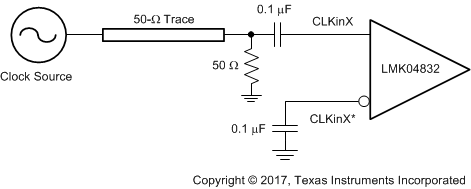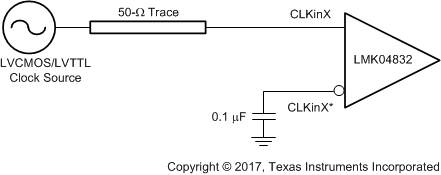ZHCSLT2C May 2020 – November 2022 LMK04832-SP
PRODUCTION DATA
- 1 特性
- 2 应用
- 3 说明
- 4 Revision History
- 5 Pin Configuration and Functions
- 6 Specifications
- 7 Parameter Measurement Information
-
8 Detailed Description
- 8.1 Overview
- 8.2 Functional Block Diagram
- 8.3 Feature Description
- 8.4 Device Functional Modes
- 8.5 Programming
- 8.6
Register Maps
- 8.6.1 Register Map for Device Programming
- 8.6.2
Device Register Descriptions
- 8.6.2.1 System Functions
- 8.6.2.2
(0x100 - 0x138) Device Clock and SYSREF Clock Output Controls
- 8.6.2.2.1 DCLKX_Y_DIV
- 8.6.2.2.2 DCLKX_Y_DDLY
- 8.6.2.2.3 CLKoutX_Y_PD, CLKoutX_Y_ODL, CLKoutX_Y_IDL, DCLKX_Y_DDLY_PD, DCLKX_Y_DDLY[9:8], DCLKX_Y_DIV[9:8]
- 8.6.2.2.4 CLKoutX_SRC_MUX, CLKoutX_Y_PD, DCLKX_Y_BYP, DCLKX_Y_DCC, DCLKX_Y_POL, DCLKX_Y_HS
- 8.6.2.2.5 CLKoutY_SRC_MUX, SCLKX_Y_PD, SCLKX_Y_DIS_MODE, SCLKX_Y_POL, SCLKX_Y_HS
- 8.6.2.2.6 SCLKX_Y_ADLY_EN, SCLKX_Y_ADLY
- 8.6.2.2.7 SCLKX_Y_DDLY
- 8.6.2.2.8 CLKoutY_FMT, CLKoutX_FMT
- 8.6.2.3
SYSREF, SYNC, and Device Config
- 8.6.2.3.1 VCO_MUX, OSCout_MUX, OSCout_FMT
- 8.6.2.3.2 SYSREF_REQ_EN, SYNC_BYPASS, SYSREF_MUX
- 8.6.2.3.3 SYSREF_DIV
- 8.6.2.3.4 SYSREF_DDLY
- 8.6.2.3.5 SYSREF_PULSE_CNT
- 8.6.2.3.6 PLL2_RCLK_MUX, PLL2_NCLK_MUX, PLL1_NCLK_MUX, FB_MUX, FB_MUX_EN
- 8.6.2.3.7 PLL1_PD, VCO_LDO_PD, VCO_PD, OSCin_PD, SYSREF_GBL_PD, SYSREF_PD, SYSREF_DDLY_PD, SYSREF_PLSR_PD
- 8.6.2.3.8 DDLYdSYSREF_EN, DDLYdX_EN
- 8.6.2.3.9 DDLYd_STEP_CNT
- 8.6.2.3.10 SYSREF_CLR, SYNC_1SHOT_EN, SYNC_POL, SYNC_EN, SYNC_PLL2_DLD, SYNC_PLL1_DLD, SYNC_MODE
- 8.6.2.3.11 SYNC_DISSYSREF, SYNC_DISX
- 8.6.2.3.12 PLL1R_SYNC_EN, PLL1R_SYNC_SRC, PLL2R_SYNC_EN, FIN0_DIV2_EN, FIN0_INPUT_TYPE
- 8.6.2.4
(0x146 - 0x149) CLKin Control
- 8.6.2.4.1 CLKin_SEL_PIN_EN, CLKin_SEL_PIN_POL, CLKin2_EN, CLKin1_EN, CLKin0_EN, CLKin2_TYPE, CLKin1_TYPE, CLKin0_TYPE
- 8.6.2.4.2 CLKin_SEL_AUTO_REVERT_EN, CLKin_SEL_AUTO_EN, CLKin_SEL_MANUAL, CLKin1_DEMUX, CLKin0_DEMUX
- 8.6.2.4.3 CLKin_SEL0_MUX, CLKin_SEL0_TYPE
- 8.6.2.4.4 SDIO_RDBK_TYPE, CLKin_SEL1_MUX, CLKin_SEL1_TYPE
- 8.6.2.5 RESET_MUX, RESET_TYPE
- 8.6.2.6
(0x14B - 0x152) Holdover
- 8.6.2.6.1 LOS_TIMEOUT, LOS_EN, TRACK_EN, HOLDOVER_FORCE, MAN_DAC_EN, MAN_DAC[9:8]
- 8.6.2.6.2 MAN_DAC
- 8.6.2.6.3 DAC_TRIP_LOW
- 8.6.2.6.4 DAC_CLK_MULT, DAC_TRIP_HIGH
- 8.6.2.6.5 DAC_CLK_CNTR
- 8.6.2.6.6 CLKin_OVERRIDE, HOLDOVER_EXIT_MODE, HOLDOVER_PLL1_DET, LOS_EXTERNAL_INPUT, HOLDOVER_VTUNE_DET, CLKin_SWITCH_CP_TRI, HOLDOVER_EN
- 8.6.2.6.7 HOLDOVER_DLD_CNT
- 8.6.2.7 (0x153 - 0x15F) PLL1 Configuration
- 8.6.2.8 (0x160 - 0x16E) PLL2 Configuration
- 8.6.2.9 (0x16F - 0x555) Misc Registers
- 9 Application and Implementation
- 10Device and Documentation Support
- 11Mechanical, Packaging, and Orderable Information
9.1.3.2 Driving CLKin Pins With a Single-Ended Source
The CLKin and OSCin pins can be driven using a single-ended reference clock source, for example, either a sine wave source or an LVCMOS/LVTTL source. CLKin supports both AC coupling or DC coupling. OSCin must use AC coupling. In the case of the sine wave source that is expecting a 50-Ω load, TI recommends using AC coupling as shown in Figure 9-4 with a 50-Ω termination.
The signal level must conform to the requirements for the CLKin or OSCin pins listed in the Section 6.5.
To support LOS functionality, CLKinX_BUF_TYPE must be set to MOS mode (CLKinX_BUF_TYPE = 1) when AC-coupled. When AC coupling, if the 100-Ω termination is placed on the IC side of the blocking capacitors, then the LOS functionality will not be valid.
 Figure 9-4 CLKinX/X* Single-Ended Termination
Figure 9-4 CLKinX/X* Single-Ended TerminationIf the CLKin pins are being driven with a single-ended LVCMOS/LVTTL source, either DC coupling or AC coupling may be used. If DC coupling is used, the CLKinX_BUF_TYPE should be set to MOS buffer mode (CLKinX_BUF_TYPE = 1) and the voltage swing of the source must meet the specifications for DC -oupled, MOS-mode clock inputs given in the Section 6.5. If AC coupling is used, the CLKinX_BUF_TYPE should be set to the bipolar buffer mode (CLKinX_BUF_TYPE = 0). The voltage swing at the input pins must meet the specifications for AC-coupled, bipolar mode clock inputs given in the Section 6.5. In this case, some attenuation of the clock input level may be required. A simple resistive divider circuit before the AC-coupling capacitor is sufficient.
 Figure 9-5 DC-Coupled LVCMOS/LVTTL Reference Clock
Figure 9-5 DC-Coupled LVCMOS/LVTTL Reference Clock